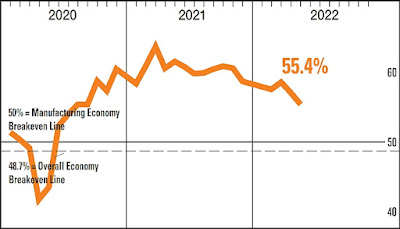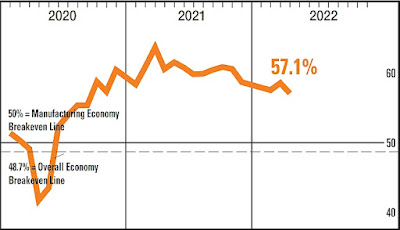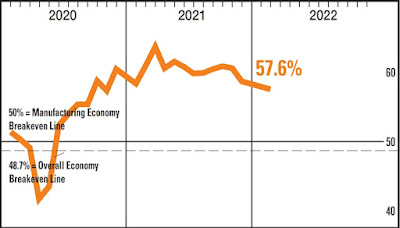ISM Manufacturing Index for NOVEMBER 2025
=========
Predicted: 48.0%
- Actual: 48.2% (-0.5 point month-on-month change)
=========
Previous month: 48.7%
=========
Every month, the ISM surveys purchasing and supply executives at hundreds of companies across the country who are involved in manufacturing in some form. The resulting index is watched closely by academics, economists and investors because manufacturing accounts for about 12% of U.S. Gross Domestic Product (GDP).
The PMI is a reliable barometer of U.S. manufacturing: A PMI above 50% implies that U.S. manufacturing expanded during the month specified, while a reading below 50% implies that the made-in-the-USA sector contracted.
=========
"...Economic activity in the manufacturing sector contracted in November for the ninth consecutive month, following a two-month expansion preceded by 26 straight months of contraction, say the nation’s supply executives in the latest ISM® Manufacturing PMI® Report..."
=========
From A Diverse Pool Of U.S. Manufacturers:
- 'New order entries are within the forecast. We have increased requests from customers to get their orders sooner. Transit time on imports seems to be longer.'
(Machinery)
- 'We are starting to institute more permanent changes due to the tariff environment. This includes reduction of staff, new guidance to shareholders, and development of additional offshore manufacturing that would have otherwise been for U.S. export.'
(Transportation Equipment)
- 'Tariffs and economic uncertainty continue to weigh on demand for adhesives and sealants, which are primarily used in building construction.'
(Chemical Products)
- 'No major changes at this time, but going into 2026, we expect to see big changes with cash flow and employee head count. The company has sold off a big part of the business that generated free cash while offering voluntary severance packages to anyone.'
(Petroleum + Coal Products)
- 'Business conditions remain soft as a result of higher costs from tariffs, the government shutdown, and increased global uncertainty.'
(Miscellaneous Manufacturing)
- 'The unstable market has made pricing fluctuate in a very volatile way; I have had to reduce suppliers for raw materials to maintain a better direct cost structure. Reducing my suppliers has reduced the availability of some items and created longer lead times.'
(Fabricated Metal Products)
- 'Business continues to be a struggle regarding long-term sourcing decisions based on tariffs and landing costs. External (or international) sourcing remains the lowest-cost solution compared to U.S. production/manufacturing. The delta is smaller now, reducing margins.'
(Computer + Electronic Products)
- 'The government shutdown has impacted our access to agricultural data, impacting agricultural markets and, as a result, decisions we make. Optimism for a tariff exemption on palm oil percolated but hasn’t come to fruition at this time.'
(Food, Beverage + Tobacco Products)
- 'Trade confusion. At any given point, trade with our international partners is clouded and difficult. Suppliers are finding more and more errors when attempting to export to the U.S. -- before I even have the opportunity to import. Freight organizations are also having difficulties overseas, contending with changing regulations and uncertainty. Conditions are more trying than during the coronavirus pandemic in terms of supply chain uncertainty.'
(Electrical Equipment, Appliances + Components)
- 'Domestic and export business have been lackluster. Our customers are taking prompt orders only and still don’t have confidence to build inventory, much less make expansion plans. In fact, most of any kind of ‘planning’ has been undermined by unpredictability due to inconsistent messaging from Washington. Artificial intelligence is in its infancy stages, producing confusing and most often inaccurate information. This also causes apprehensive consumer buying patterns, contributing to the challenge of forecasting demand.'
(Wood Products)
==========
November 2025 Update
Labels: FedPrimeRate, FedPrimeRate.com, hard_data, inflation, ism, manufacturing, pmi, purchasing_managers_index, Stagflation, Supply_Chain, tariffs, Trump_Tariffs
|
--> www.FedPrimeRate.com Privacy Policy <--
CLICK HERE to JUMP to the TOP of THIS PAGE > SITEMAP < |















